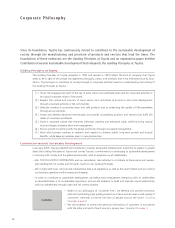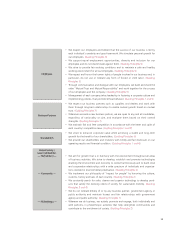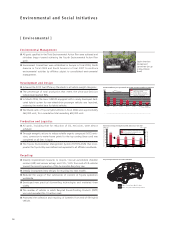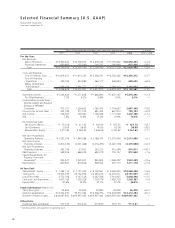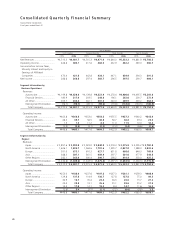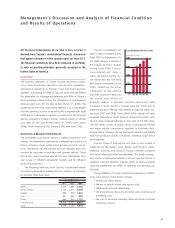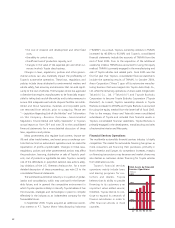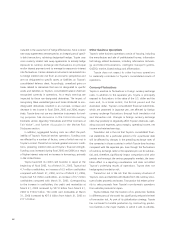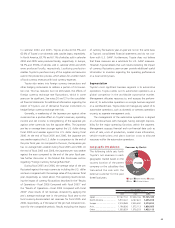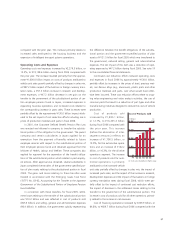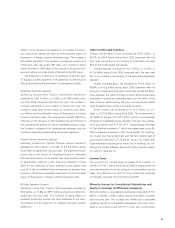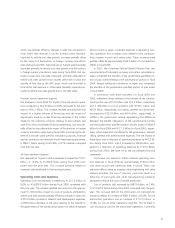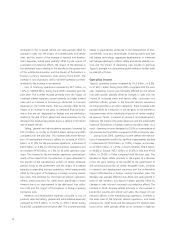Toyota 2006 Annual Report Download - page 64
Download and view the complete annual report
Please find page 64 of the 2006 Toyota annual report below. You can navigate through the pages in the report by either clicking on the pages listed below, or by using the keyword search tool below to find specific information within the annual report.
62
• the cost of research and development and other fixed
costs,
• the ability to control costs,
• the efficient use of production capacity, and
• changes in the value of the Japanese yen and other cur-
rencies in which Toyota does business.
Changes in laws, regulations, policies and other govern-
mental actions can also materially impact the profitability of
Toyota’s automotive operations. These laws, regulations and
policies include those attributed to environmental matters and
vehicle safety, fuel economy and emissions that can add signifi-
cantly to the cost of vehicles. The European Union has approved
a directive that requires manufacturers to be financially respon-
sible for taking back end-of-life vehicles and to take measures to
ensure that adequate used vehicle disposal facilities are estab-
lished and those hazardous materials and recyclable parts
are removed from vehicles prior to scrapping. Please see
“—Legislation Regarding End-of-Life Vehicles” and “Information
on the Company—Business Overview—Governmental
Regulation, Environmental and Safety Standards” in Toyota’s
annual report on Form 20-F and note 23 to the consolidated
financial statements for a more detailed discussion of these
laws, regulations and policies.
Many governments also regulate local content, impose tar-
iffs and other trade barriers, and enact price or exchange con-
trols that can limit an automaker’s operations and can make the
repatriation of profits unpredictable. Changes in these laws,
regulations, policies and other governmental actions may affect
the production, licensing, distribution or sale of Toyota’s prod-
ucts, cost of products or applicable tax rates. Toyota is currently
one of the defendants in purported national class actions alleg-
ing violations of the U.S. Sherman Antitrust Act. For a more
detailed description of these proceedings, see note 23 to the
consolidated financial statements.
The worldwide automotive industry is in a period of global-
ization and consolidation, which may continue for the foresee-
able future, and in general the competitive environment in
which Toyota operates is likely to intensify. Toyota believes it has
the resources, strategies and technologies in place to compete
effectively in the industry as an independent company for the
foreseeable future.
In September 2003, Toyota acquired an additional owner-
ship interest in P.T. Toyota Motor Manufacturing Indonesia
(“TMMIN”). As a result, Toyota’s ownership interests in TMMIN
increased by 46.00% to 95.00% and Toyota’s consolidated
financial statements include the accounts of TMMIN from the
end of fiscal 2004. Prior to the acquisition of the additional
ownership interest, TMMIN was accounted for using the equity
method. TMMIN is primarily engaged in the manufacturing and
sale of Toyota vehicles and related parts. Fiscal 2005 was the
first full year that Toyota’s consolidated financial statements
include the operating results of TMMIN. In October 2004,
Araco Corporation (“Araco”) spun off its automotive manufac-
turing business that was merged into Toyota Auto Body Co.,
Ltd. while the remaining operations of Araco were merged with
Takanichi Co., Ltd. (“Takanichi”) and Toyoda Boshoku
Corporation to become Toyota Boshoku Corporation (“Toyota
Boshoku”). As a result, Toyota’s ownership interests in Toyota
Boshoku increased to 49.63% and Toyota Boshoku is accounted
for using the equity method from the latter half of fiscal 2005.
Prior to the merger, Araco and Takanichi were consolidated
subsidiaries of Toyota and included their financial results in
Toyota’s consolidated financial statements. Toyota Boshoku is
primarily engaged in the development, manufacturing and sales
of automotive interior and filter parts.
Financial Services Operations
The worldwide automobile financial services industry is highly
competitive. The market for automobile financing has grown as
more consumers are financing their purchases, primarily in
North America and Europe. As competition increases, margins
on financing transactions may decrease and market share may
also decline as customers obtain financing for Toyota vehicles
from alternative sources.
Toyota’s financial services
operations mainly include loans
and leasing programs for cus-
tomers and dealers. Toyota
believes that its ability to provide
financing to its customers is an
important value added service;
therefore, Toyota intends to con-
tinue to expand its network of
finance subsidiaries in order to
offer financial services in more
countries.
6,000
3,000
9,000
12,000
’02 ’03 ’04 ’05 ’06
0
Total Assets by Financial
Services Operations
(¥ Billion)
FY


